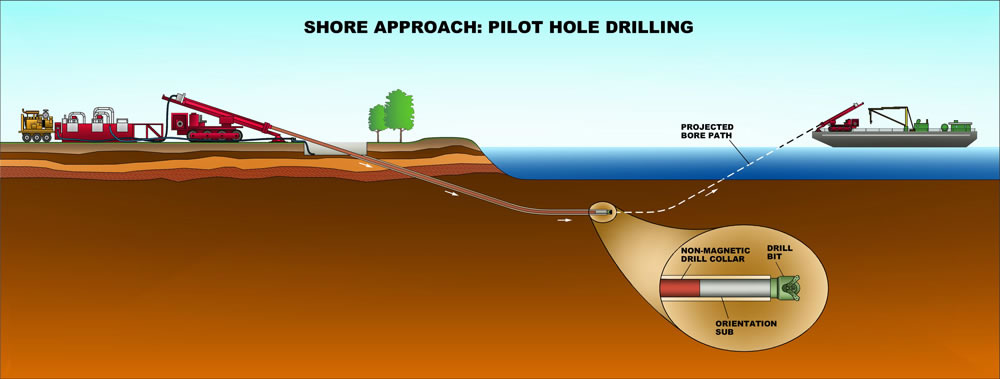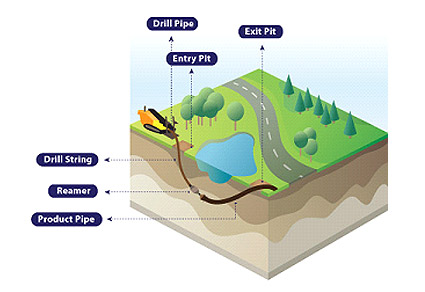What is Horizontal Directional Drilling
Horizontal Directional Drilling (HDD) is a method of installing underground pipelines, cables and service conduit through trenchless methods. It involves the use of a directional drilling machine, and associated attachments, to accurately drill along the chosen bore path and back ream the required pipe.
Directional drilling is a three stage process:
Pilot Hole
The first stage consists of drilling a small diameter pilot hole. Drilling fluid is pumped through the drill pipe to the drill bit where high pressure jets and the bit will grind the soils ahead of the drill stem. The drilling fluid will also carry the cuttings back to the entrance pit at the drill rig. Tracking of the pilot hole can be done in several ways depending on the size and complexity of the shot. Smaller shots are done using a walkover guidance system whereas the larger more complex shots have a wire line magnetics type system. With both methods there is a transmitter or steering tool located near the drill head which sends a signal to the location engineer giving the exact coordinates of the drill stem. Readings are constantly taken which check the depth, alignment and percent slope of the drill head.

Corrections will be made by the operator and locator to keep the pilot hole along the predetermined bore path. The speed of the pilot hole will vary upon existing soil conditions and the amount of steering which is required. Upon reaching the exit point, the beacon housing and bit is detached and replaced with a reamer.
Pre-Reaming
The second step is to pre-ream the pilot hole and enlarge it to a size sufficient to safely install the product lines. A reamer is pulled back and rotated while pumping drilling fluid to cut and remove solids to enlarge the hole. Pre-reaming speeds will vary depending on existing soil conditions and the amount of cuttings that are removed from the hole.

Bentonite and other additives will be used to ensure a clean and stable hole. Bentonite is used to create a “cake layer” around the outside of the hole during pre-reaming. This will help with the stability of the bore hole and with fluid loss or infiltration. Additives such as polymers are used to help break up the clay soils. A more evenly mixed drilling fluid will prevent any blockages inside of the bore hole.
Pipe Pullback
The final step is the pullback of the pipe within the pre-reamed hole. The drill rod and reamer will be attached to a swivel, which is utilized between the product line and the reamer to prevent any torsional stress from the rotating drill string being transferred to the product pipe. As the product pipe is pulled into the drill hole, drilling fluid is pumped downhole to provide lubrication to the product pipe.